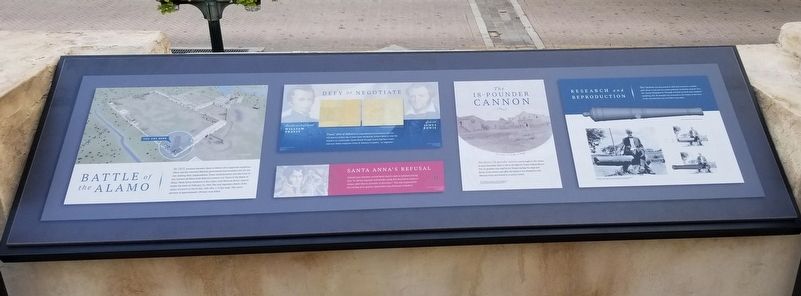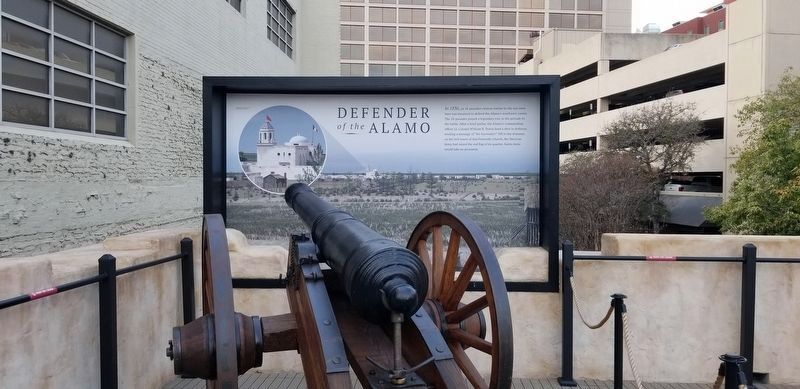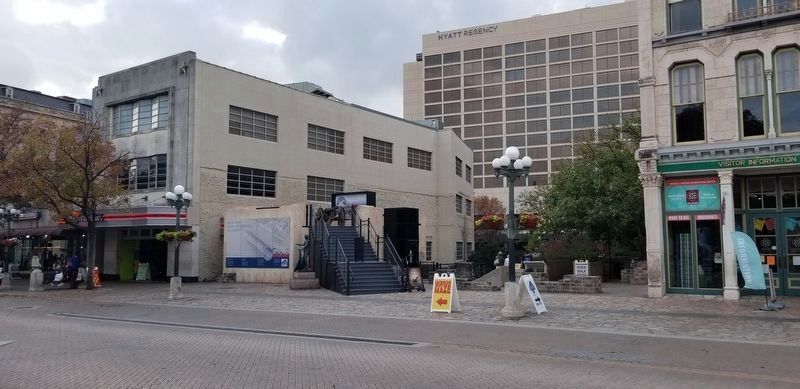Alamo Plaza in San Antonio in Bexar County, Texas — The American South (West South Central)
Battle of the Alamo
Defy or Negotiate
Travis' shot of defiance is remembered for its bravery, but the full history of that day is even more intriguing. Letters show us that the Alamo's co-commander James Bowie thought Travis had been hasty and sent Alamo engineer Green B. Jameson to parley - or negotiate.
Captions
Left Photo: Lieutenant Colonel William Travis
Painting of William B. Travis, 1936
Hugo D. Pohl
The Alamo Collection
C2020-0135
Right Photo: Colonel James Bowie
Portrait of James Bowie, undated
John Squire Adams
The Alamo Collection
C-2020-1937
Center: William B. Travis - Letter from the Alamo, February 24, 1836
Courtesy of Texas State Library and Archives Commission
Santa Anna's Refusal
Colonel Juan Almonte carried Santa Anna's reply to Jameson stating that "he did not negotiate with bandits, [and] that they had no means to escape, other than to surrender at discretion." This was supported by the red flag of no quarter raised above San Fernando Cathedral.
Caption
Left Photo: Antonio Lopez de Santa Anna, ca 1996
Gary Zaboly
The Alamo Collection
C2020-0179
The 18-Pounder Cannon
The Alamo 18-pounder cannon was brought to the Alamo in early December 1835 to aid in the fight for Texan Independence. The 18-pounder was used by the Texans during the siege and Battle of the Alamo, and after the battle it was disabled by the Mexican Army and buried in a nearby trench.
Above: Photograph of the Alamo, ca. 1858. The 18-pounder cannon can be seen in the foreground. Reproduced with the permission of the DRY Collection at Texas A&M University-San Antonio.
Research and Reproduction
The Cannon was discovered in 1858 and moved to a nearby park where it was put on a stone pedestal. Sometime around 1917, the cannon disappeared. Through archival research and computer modeling, the 18-pounder has returned to the Alamo in the form of the reproduction you see before you
today.
Captions
Lower Left: Photograph of Fernando Raven with the 18-pounder cannon in the 1910s. The photograph was provided by Geenie Reetz, the great-great granddaughter of Fernando Raven.
Middle Right: Research, rendering, and fabrication by SRO Associates
Erected 2021 by The Alamo Organization.
Topics. This historical marker is listed in these topic lists: Anthropology & Archaeology • Forts and Castles • War, Texas Independence. A significant historical date for this entry is February 23, 1836.
Location. 29° 25.534′ N, 98° 29.227′ W. Marker is in San Antonio, Texas, in Bexar County. It is in Alamo Plaza. Marker is at the intersection of Alamo Plaza and East Crockett Street, on the right on Alamo Plaza. The marker and cannon are located across the street from the Alamo on Alamo Plaza. Touch for map. Marker is at or near this postal address: 300 Alamo Plaza, San Antonio TX 78205, United States of America. Touch for directions.
Other nearby markers. At least 8 other markers are within walking distance of this marker. Defender of the Alamo (a few steps from this marker); The Alamo in 1836 (a few steps from this marker); Mission San Antonio de Valero Indian Quarters (a few steps from this marker); The Alamo / El Alamo (a few steps from this marker); Southwestern Room
(a few steps from this marker); Alamo Low Barracks and Main Gateway (within shouting distance of this marker); a different marker also named The Alamo in 1836 (within shouting distance of this marker); a different marker also named The Alamo in 1836 (within shouting distance of this marker). Touch for a list and map of all markers in San Antonio.
Also see . . . Battle of the Alamo.
The siege and the final assault on the Alamo in 1836 constitute the most celebrated military engagement in Texas history. The battle was conspicuous for the large number of illustrious personalities among its combatants. These included Tennessee congressman David Crockett, entrepreneur-adventurer James Bowie, and Mexican president Antonio López de Santa Anna. Although not nationally famous at the time, William Barret Travis achieved lasting distinction as commander at the Alamo. For many Americans and most Texans, the battle has become a symbol of patriotic sacrifice. Traditional popular depictions, including novels, stage plays, and motion pictures, emphasize legendary aspects that often obscure the historical event. Source: The Handbook of Texas(Submitted on December 20, 2021, by James Hulse of Medina, Texas.)
Credits. This page was last revised on February 2, 2023. It was originally submitted on December 20, 2021, by James Hulse of Medina, Texas. This page has been viewed 392 times since then and 57 times this year. Photos: 1, 2, 3. submitted on December 21, 2021, by James Hulse of Medina, Texas.


